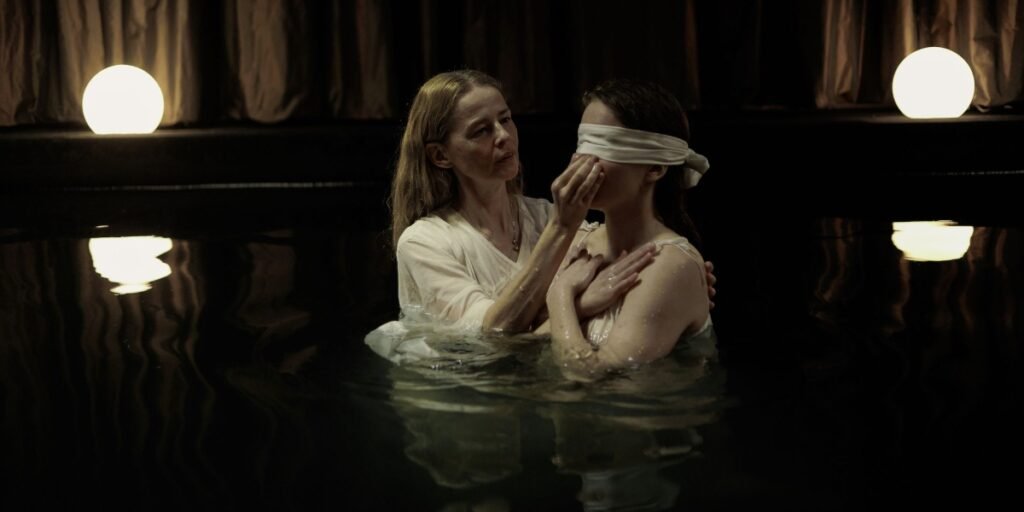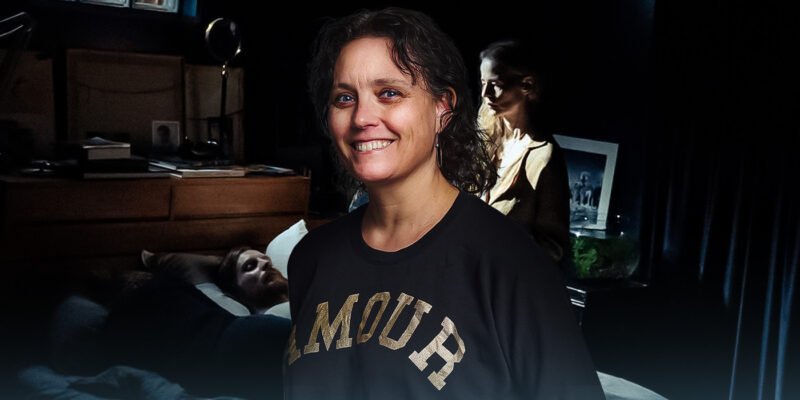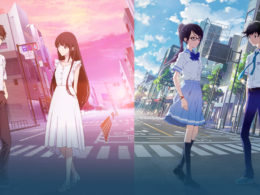Natatorium, a new Icelandic family-horror film, has its North American premiere this week at SXSW in Austin, Texas. The film follows 18-year-old Lilja as she visits her estranged grandparents while auditioning for a play in town. She quickly becomes ensnared in the family’s dark secrets of the past while she faces life-threatening decisions the longer she stays with them.
Agents of Fandom‘s Ethan Simmie got to sit down with Helena Stefánsdóttir, the director of the film, to talk about what it feels like to have her film premiere at SXSW, the personal trauma that washed over the script, and her dark past with swimming pools!
‘Natatorium’ Premieres on Opening Night at SXSW

ETHAN SIMMIE: Thanks for taking the time with me to talk about your newest and your first feature film which is super incredible. How does that feel in general just to know you have a feature film under your belt now?
HELENA STEFÁNSDÓTTIR: Well, it feels so good! But I think also because it’s been so well-received everywhere — in the press and within the critics world and also the audience — that makes it just like extreme bliss, basically. Of course, it’s been a long journey and it’s a relief to have released the film but the good reception is a huge bonus.
ETHAN SIMMIE: The North American premiere is happening at SXSW. It’s actually happening on opening night which I’m sure is pretty exciting for you as well. What does it feel like to have the North American premiere of your film take place at such a big film festival in the United States?
HELENA STEFÁNSDÓTTIR: It was just such a huge surprise. I wasn’t expecting anything. I was just making a film and then all of a sudden I got this news that it was going to be there. So this was a surprise! But it’s a nice surprise, of course. But I’m really, really excited. I’m hoping to meet a lot of people and maybe make some connections in the States and get some networking.
ETHAN SIMMIE: Well, I have seen the film and I’m excited to let people know it’s absolutely worth seeing on opening night of SXSW. What is the toughest leap going from a short film to a feature film and having a time gap of 13 years in between making projects?
HELENA STEFÁNSDÓTTIR: I have to say that I made a short film in 2012 and I made a documentary in 2016 and I made a short film in 2018 also.
ETHAN SIMMIE: Well, you’ve got to get IMDb updated because IMDb does not have that information!
HELENA STEFÁNSDÓTTIR: They don’t know anything! They only know half of the story. I was trying to update my IMDb page and it was so frustrating that I gave up after someone helped me. So the time gap is not that big. But I have to say that being somehow forced to do so many other jobs to be able to buy food and pay the rent is a bit frustrating.
I think I would have finished this film earlier if I wouldn’t have to do that, you know, take other jobs. That has been quite hard. But maybe it’s worth it. Maybe life just gives you what you need when you need it. I mean, if I see it like that in the bigger picture, then maybe this is the perfect timing. But at points, I have been, I’ve been a bit angry or resentful to “life” for having to do other jobs, basically, which has taken away from me the time to develop this.
ETHAN SIMMIE: Have you had this idea for a while? Have you wanted to make this movie for a long time? It sounds like it’s something that you’ve known that you’ve wanted to make for some time now.
HELENA STEFÁNSDÓTTIR: Yeah. I had a script for a short film back in 2012 or something that was supposed to be a short film, but then I gradually realized that it needed to be a bigger story. That it needed a bigger context. It was about siblings and I needed a family around them. I think back then in 2012 or 2013 I realized that I wanted to make this film.
I saw this image of this family dinner where the kids are there and the parents and everything is perfect on the surface, but it’s really not so nice under the surface. Of course, the characters that gradually pop in from different directions — you don’t have them all readymade all of a sudden. It takes time to spice the story with different characters, different syndromes, different stuff like that.
Helena Stefánsdóttir Pulled Deeply From Her Personal Experiences in ‘Natatorium’
ETHAN SIMMIE: It seems like you might have drawn on some personal experiences or ideas or other things for this film. Is there anything that you used from your life to kind of construct the bones of this movie?
HELENA STEFÁNSDÓTTIR: There’s a lot, especially in the dialogue, that I recognize in myself. The way I would maybe react to something like if you feel some pain or resentment or irritation or fear, for instance, then you react in a way that is irrational, but then when you start talking about it and if you start to analyze it, then you realize that you’re basically not angry but you’re scared.
In that sense, there’s a lot from my own experience. A lot of the characters or the characteristics of the characters, like the Munchausen by proxy syndrome, the addiction to drowning, the drinking problem — that’s just something that I have seen in my life or read about. It’s not my experience. It’s mainly in the dialogue that I take something from myself and maybe I also take something from my upbringing, from my childhood memories and stuff like that.
ETHAN SIMMIE: You did call out the dinner scene, which I think is one of the more horrific scenes in the film, at least for me. I’m curious on the kind of the technical aspect of that. What was it like filming that scene? Because you do have six different actors and people with different afflictions or traumas that are all coinciding at the same time with a very kind of smooth, synchronous camera flow moving around the table, capturing segments of their lives. How was that for you as the director, putting that all together in that scene and really kind of capturing the pinnacle of everybody finally getting together?
HELENA STEFÁNSDÓTTIR: Well it took three days to film that scene. It took a long time. And we started it from a lot of different angles. But this shot where the camera turns around was something that I had decided to do. I really wanted that. I didn’t know if I was going to be able to use it. I just knew that I wanted it and I had to fight for it because it was technically a bit difficult, both for the cameraperson and for the focus puller.
The actors are different heights at the table so you had to roll the camera with a remote control and also pan down and up at the same time. So it was technically quite hard. But I insisted! I wanted it. So we ended up doing it on day three. But before that, we had done a shot from above and a lot of different shots that we’re not using because I kind of didn’t know what result would be the most effective. Then I was in the editing room and I realized that this one was the most effective. I’m very, very glad that I could do it.
HELENA STEFÁNSDÓTTIR: I’m glad that you fought for that because I thought it was a very effective scene for sure. I don’t know if I’m ever going to be able to swim in a pool again after watching this movie. Do you have a personal trauma with swimming pools? That’s a very key element of the film and I can only imagine you might have had a bad experience in a swimming pool one time.
HELENA STEFÁNSDÓTTIR: I actually do. Wow, you’re very clever. I actually have a trauma experience from a swimming pool from when I was 11 or 12 and it kind of marked me for a very, very long time and I never, ever go to swimming pools. Can you believe it? I hate swimming! Being an Icelander, you know, everybody, I’m saying 99.9% of the people, go to the swimming pool many times a week. Some people every day, like my sister, every single day. It is just a swimming pool nation. And people are like, “What? You don’t swim?”. And I’m like “No.”
ETHAN SIMMIE: Hopefully creating this movie helped to work out some of that trauma, at least, for swimming pools. Helena, thank you so much for the time and talking about your new film, Natatorium, which is premiering at SXSW. Really an incredible, art-driven, trauma-driven horror film. Congratulations on your first feature film.
HELENA STEFÁNSDÓTTIR: Thank you so much for your kind words and clever and intelligent questions.
Follow the Agents of Fandom socials for more SXSW coverage, including reviews and interviews.











